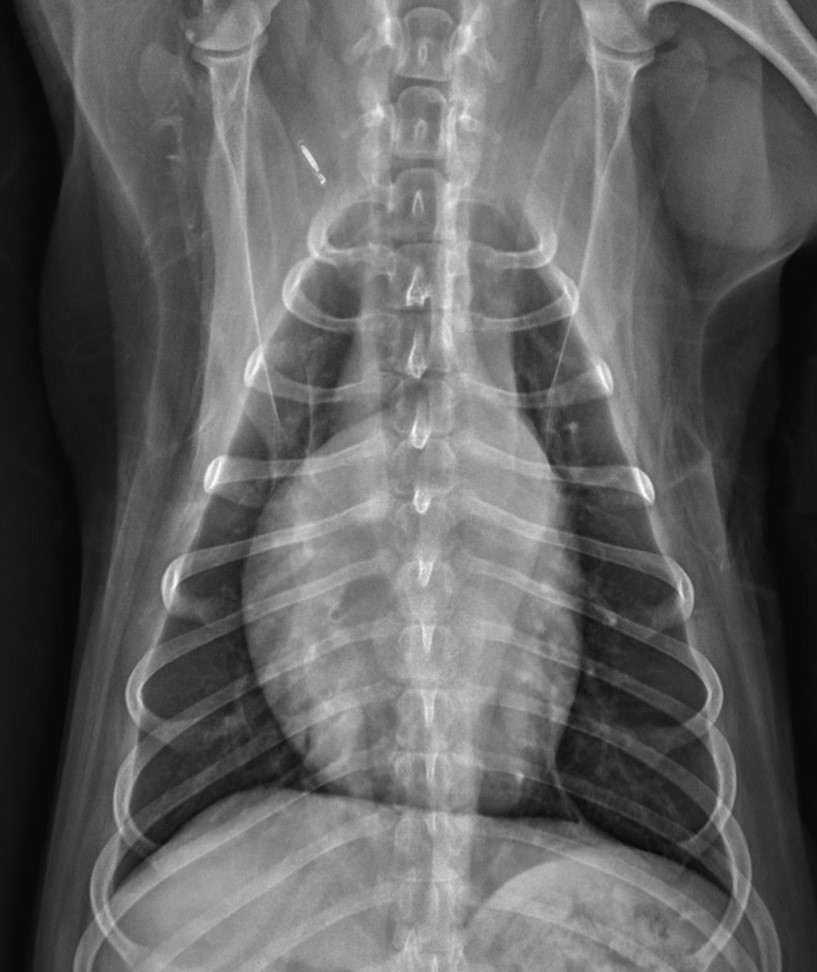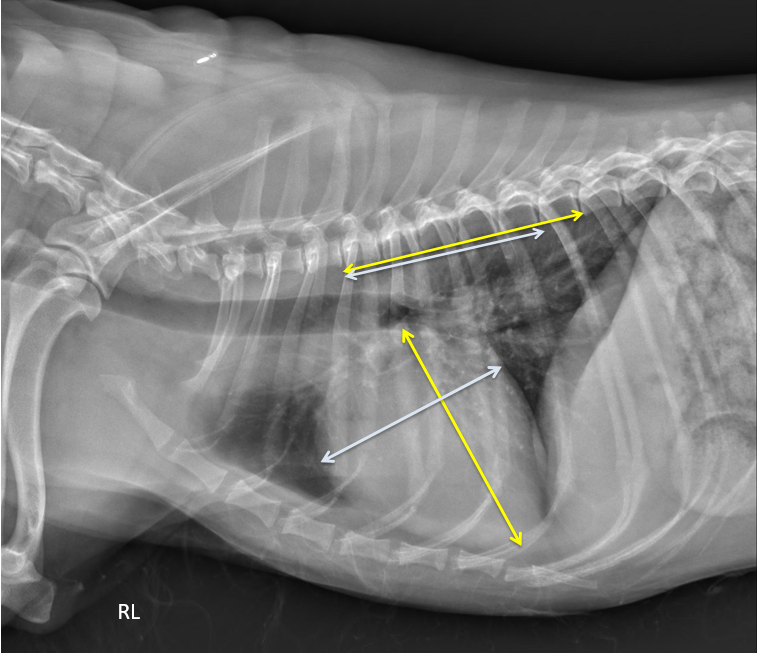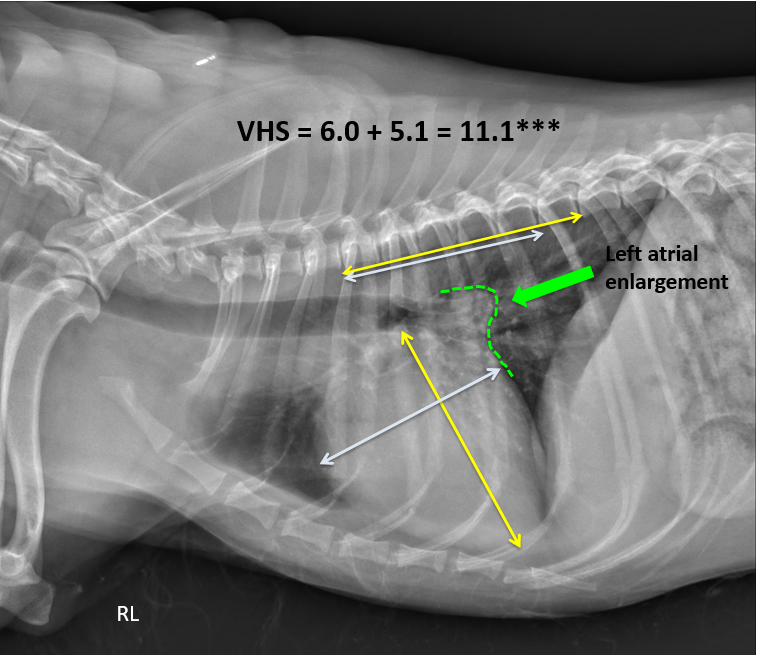
Sasha
 Case Background
Case Background
Age: 9.5 years old
Sex: Female
Breed: Cavalier King Charles Spaniel
Weight: 8.8 lbs (4.0 kg)
Reason for visit: Annual wellness evaluation
Medications: Heartworm prophylaxis, flea and tick prevention
 Clinical History
Clinical History
Coughing: None
Respiration: Normal
Exercise tolerance: Normal
Sleep patterns: Normal
Weight change (loss or gain): None
Appetite: Normal
Usual diet: Royal Canin® adult small breed dried dog food
Vomiting: None
Diarrhea: None
Syncope: None
Change in urinary habits: None
Change in drinking habits: None
Living circumstances: Indoor with outdoor privileges under supervision, one other healthy dog
 Physical Exam - General
Physical Exam - General
Attitude: Bright, alert, responsive
Mobility | gait: Normal
Posture: Normal
Hydration: Normal
Body temperature: 101.1 F
Arterial pulse – rate, regularity, intensity: 110 bpm, regular rhythm, normal amplitude
Rate & respiratory effort: 32 with normal effort
Mucous membranes – color & CRT: Light pink
Jugular venous pulse & pressure: Not examined
Abdominal palpatation: Normal
Lymph nodes: Normal
Oral cavity: Severe tartar and gingivitis
Other abnormalities: None
 Physical Exam - Auscultation
Physical Exam - Auscultation
Let’s ascult Sasha’s heart. (Recommend high-end headphones)
Palpitation of the chest wall overlying the heart (precordial palpitation) was normal. Sasha’s lung sounds are normal. These heart sounds were heard when the stethoscope was positioned over Sasha’s left apex. Listen to Sasha’s heart Physical Exam - Differential Diagnosis
Physical Exam - Differential Diagnosis
- High (could explain most or all of the signs)
- Possible (less likely to explain most of the signs)
- Unlikely
 Diagnostic Test Selection
Diagnostic Test Selection
 Blood Pressure
Blood Pressure
Diastolic blood pressure: Not available for this case
Mean blood pressure: Not available for this case
Consensus Statements of the American College of Veterinary Internal Medicine (ACVIM) provides the veterinary community with up-to-date information on the pathophysiology, diagnosis, and treatment of clinically important animal diseases. In 2018, ACVIM published updated guidelines for the identification, evaluation, and management of systemic hypertension in dogs and cats in the the Journal of Veterinary Internal Medicine.
Click here to view and download a PDF of the ACVIM consensus statement, guidelines for the identification, evaluation, and management of systemic hypertension in dogs and cats.
 Radiography
Radiography
Please review Sasha’s thoracic radiographs.
Click here for Sasha’s radiograph viewer (measure VHS and VLAS here) View the ventral dorsal radiograph Clinical Labs
Clinical Labs
SERUM CHEMISTRIES
BUN: 13 mg/dL, Normal: <30 mg/dLCreatinine: 0.88 mg/dL, Normal: <2.1 mg/dL
Sodium: 146 mEq/L, Normal:138 – 154 mEq/L
Potassium: 3.8 mEq/L, Normal: 3.6 – 5.2 mEq/L
Chloride: 113 mmol/L, Normal: 105 – 119 mEq/L
ALT: 55 IU/L, Normal: <75 IU/L
ALP: 28 IU/L, Normal: <100 IU/L
CBC
White blood cells: N/ARed blood cells: PCV = 42% Total Solids = 6.2 g/dl
Platelets: N/A
 Echocardiography
Echocardiography
Please review the results of Sasha’s echo.
Watch echo #1Watch echo #2
Watch echo #3
Watch echo #4
Subjective – lesions of valves, myocardium, pericardial space: The anterior and posterior leaflet were moderately thickened, with evidence of prolapse of the anterior valve leaflets. The cardiac rhythm was a normal sinus rhythm throughout the exam. No other abnormalities were noted.
LV chamber size and thickness: The left ventricular (LV) chamber size was normal in systole suggestive of preserved systolic function. The left ventricular chamber size was increased (dilated) in diastole with a calculated normalized index of 1.89.
Left atrial size: The left atrium (LA) was moderately dilated with a left atrial to aortic (Ao) ratio (2D, Swedish Method) = 1.6
LVIDd & LVIDs: LVIDd=3.59 cm (Index 1.89), LVIDs=2.04 cm (Index 1.03)
LV shortening fraction 43%
RA, RV and pulmonary artery: Right atrium (RA), right ventricle and main pulmonary artery were normal in size.
Effusions: None
Doppler results: Severe mitral regurgitation based on color Doppler imaging; turbulent flow fills the left atrium during systole. There was mild tricuspid regurgitation based on color Doppler the velocity was normal (2.6 m/sec). Normal velocity tricuspid regurgitation argues against pulmonary hypertension at this time.
 ECG
ECG
 Referral
Referral
 Diagnosis & Treatment
Diagnosis & Treatment
You’re ready to form a diagnosis and treatment plan for Sasha! Please select your answer to each question below.
 Follow Up
Follow Up
 Post Test - CE
Post Test - CE
To qualify for CE credit, please answer the following 5 questions.
 RACE Certification
RACE Certification
RACE Certification
Fill out the following form in order to receive your certificate.


